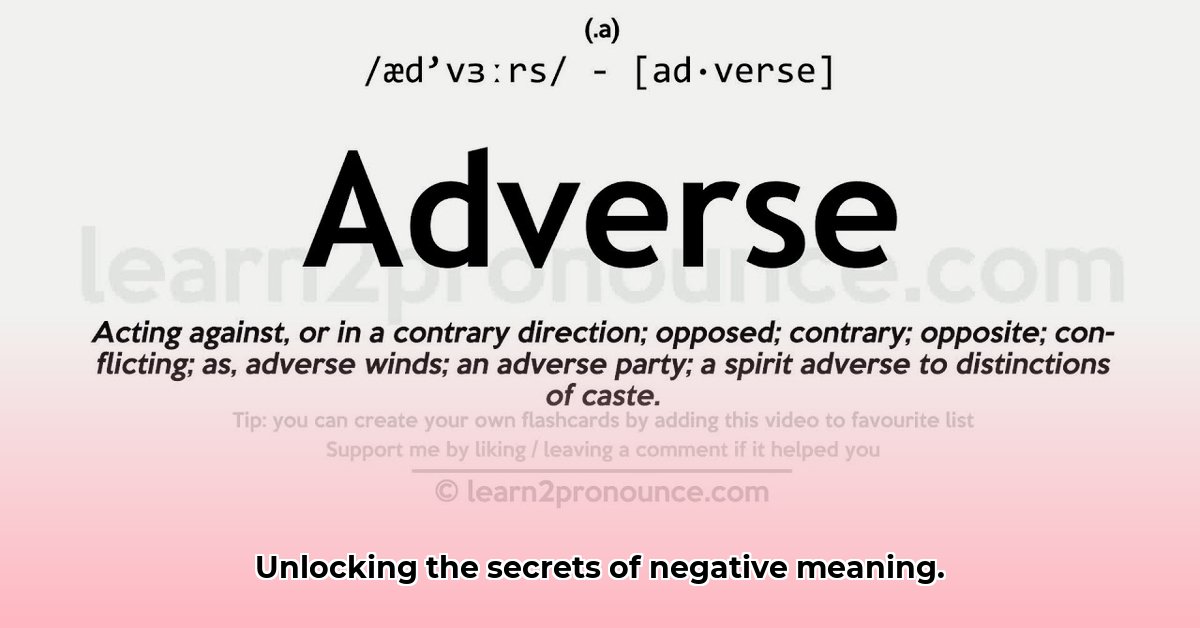
Understanding and Addressing Unwanted Outcomes
Unexpected negative consequences – what we'll call "adverse meaning" – affect every aspect of life, from healthcare to environmental policy and even our daily routines. This guide explores this pervasive issue, examining its complexities and offering actionable strategies for mitigation. We'll delve into how adverse meaning manifests across different fields, explore the challenges of measurement, and provide practical steps for minimizing its impact. Think of a flat tyre – annoying on its own, but a catastrophe if it happens during an emergency. That’s the essence of adverse meaning; it's not just about the negative event, but its context and cascading effects.
Defining the Problem: What is Adverse Meaning?
Defining adverse meaning precisely is tricky. At its core, it represents the interpretation of an outcome as harmful or undesirable – the unintended negative consequences of an action or event. Whether it's a medical side effect, a failed business venture, or environmental damage, the common thread is an unwanted, negative outcome. The challenge lies in developing consistent methods for understanding and measuring its impact across diverse sectors.
Measuring the Immeasurable: The Challenge of Quantification
Quantifying the impact of adverse meaning presents a significant hurdle. How do you assign a numerical value to the environmental damage from pollution or the emotional toll of job loss? The lack of universally accepted measurement tools hinders cross-sectoral comparison and effective resource allocation. This is an area demanding ongoing research and development.
Adverse Meaning Across Disciplines
The influence of adverse meaning is widespread:
Healthcare: Adverse drug reactions (ADRs) (unwanted side effects from medication) are a prime example. Effective mitigation requires robust reporting systems, patient education, and advanced predictive modelling to minimize risks and improve patient safety.
Environment: Climate change exemplifies the devastating, long-term effects of adverse meaning on a global scale. Extreme weather events, pollution, and resource scarcity are all stark consequences.
Legal Systems: Court rulings can have far-reaching implications, impacting individuals and businesses alike. It's crucial to consider the broad, often unanticipated effects of legal decisions.
The common thread is the unwanted, undesirable consequence of an action or event.
A Multi-Pronged Approach to Mitigation
Addressing adverse meaning requires a coordinated effort across various stakeholders:
Stakeholder Actions for Mitigation
| Stakeholder | Short-Term Actions | Long-Term Strategies |
|---|---|---|
| Healthcare Professionals | Enhanced reporting systems, improved patient communication, proactive risk assessment | Personalised medicine, predictive analytics for ADRs, targeted research into adverse event causes |
| Researchers | Development of standardised measurement tools, advanced data analysis techniques | Interdisciplinary research collaborations, focus on understanding causal mechanisms |
| Government Agencies | Policy revisions reflecting current understanding, improved regulatory oversight | Proactive hazard management, evidence-based policy formulation |
| Businesses (e.g., Pharma) | Rigorous product testing, transparent communication of potential risks | Enhanced product development processes, rapid response to adverse events, ethical and responsible product stewardship |
| The Public | Active participation in reporting adverse events, increased awareness of potential risks | Active engagement in demanding transparency and accountability from institutions and advocating for tighter safety regulations |
Clear Communication: The Foundation of Effective Mitigation
Precise terminology is vital. Confusing "adverse" (harmful effects) with "averse" (negative feelings) hampers effective communication and collaboration. Accurate language is essential in research, policy, and public discourse.
Collaboration: The Key to Success
Tackling adverse meaning requires a collaborative, multi-disciplinary approach. Improved data sharing, investment in research, and shared understanding are vital for progressing toward more effective prediction and mitigation strategies. A unified, proactive approach is needed to minimize the impact of unwanted outcomes.
Quantifying the Economic Impact of Adverse Drug Reactions in South Africa
Adverse drug reactions (ADRs) impose a significant economic burden on South Africa's healthcare system. However, accurately measuring this cost is challenging due to inconsistent methodologies and underreporting of indirect costs.
Addressing the Challenges of ADR Costing
To improve the accuracy of ADR cost estimations in South Africa, we need:
Standardized Methodologies: Adopting a nationally consistent approach to calculating ADR costs (including direct and indirect expenses).
Comprehensive Data Collection: Implementing improved reporting systems across healthcare facilities to capture ADR frequency and severity, leveraging electronic health records.
Inter-disciplinary Collaboration: Fostering collaboration between healthcare providers, researchers, policymakers, and pharmaceutical companies.
Inclusion of Indirect Costs: Developing methods for evaluating indirect costs such as loss of productivity and informal caregiving.
Leveraging Existing Infrastructure: Integrating ADR monitoring into existing health surveillance systems (e.g., for HIV/AIDS and TB).
Robust pharmacovigilance (PV) systems, including active surveillance, are central to identifying ADRs and mitigating their impact. However, underreporting remains a significant obstacle. A comprehensive approach incorporating these elements is essential for achieving precise and reliable quantification of the economic impact of ADRs in South Africa.